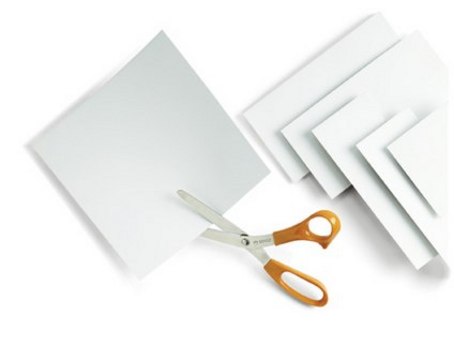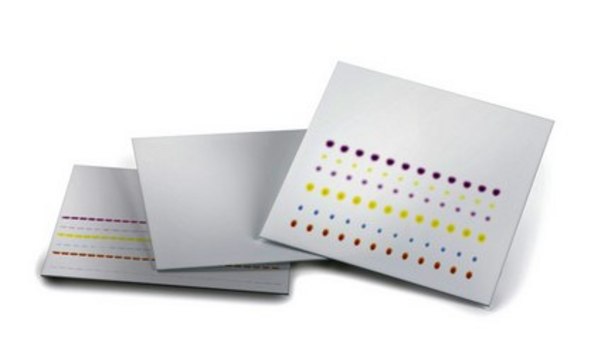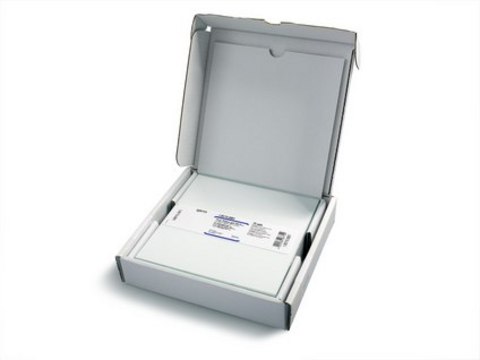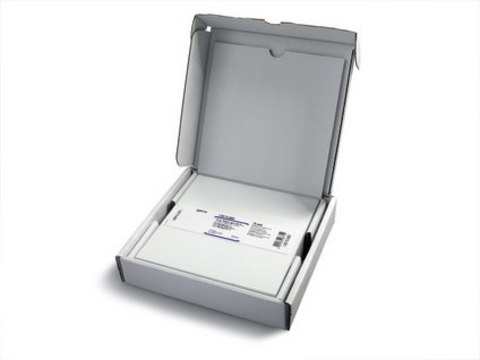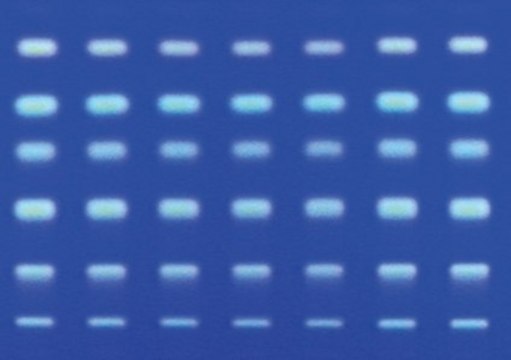1.05716
TLC plates, Cellulose
pkg of 25 plates, plate L × W 20 cm × 20 cm, glass support
Synonym(s):
Cellulose Thin Layer Chromatography Plates
Sign Into View Organizational & Contract Pricing
All Photos(1)
About This Item
UNSPSC Code:
41115711
NACRES:
NB.21
Recommended Products
material
cellulose matrix
glass support
Quality Level
feature
binder Organic Polymer
fluorescent indicator: no
packaging
pkg of 25 plates
technique(s)
thin layer chromatography (TLC): suitable
layer thickness
80-120 μm
plate L × W
20 cm × 20 cm
storage temp.
2-30°C
General description
25 Glass plates 20 x 20 cm
Cellulose plates are used to analyze polar substances. An organic sorbent, cellulose is perfect for separating hydrophilic substances by partition chromatography. Typical applications include the analysis of amino acids, carbohydrates, and phosphates as well as nucleic acid and nucleic acid derivatives. We offer cellulose plates in two grades: TLC for conventional and HPTLC for demanding, high-performance separations.
Application
- Rapid and sensitive naked eye detection of faecal pigments using their enhanced solid-state green fluorescence on a zinc acetate substrate.: This study highlights a rapid and sensitive method for detecting fecal pigments using cellulose TLC plates and zinc acetate substrate, which enhances green fluorescence visible to the naked eye (Prakash and Mishra, 2022).
- Long-Term Fluorescence Behavior of CdSe/ZnS Quantum Dots on Various Planar Chromatographic Stationary Phases.: This research investigates the fluorescence behavior of quantum dots on cellulose TLC plates, providing insights into their long-term stability and potential analytical applications (Zarzycki, 2022).
- Investigation of Hybrid Methods for Elimination of Brilliant Blue Dye from Water Phase Using Various Nanomaterials Combined with Activated Sludge and Duckweed.: This article explores the use of nanomaterials, including cellulose TLC plates, for the effective removal of dyes from water, demonstrating their utility in environmental chemistry (Zarzycki et al., 2021).
- Low-Temperature Plasma Probe Mass Spectrometry for Analytes Separated on Thin-Layer Chromatography Plates: Direct vs Laser Assisted Desorption.: This research compares direct and laser-assisted desorption methods for analytes separated on cellulose TLC plates, highlighting advancements in mass spectrometry techniques (Gong et al., 2020).
Linkage
Replaces: 5716-7; 5716
Analysis Note
Layer thickness: 80 - 120 µm
Deviation of layer thickness per plate: ≤ 30 µm
Aminoacid test
hRf-values
- L-serine, amino acid test:
20 - 30
- L-threonine, amino acid test: 29 - 36
- L-alanine, amino acid test: 30 - 40
- L-methionine, amino acid test: 49 - 60
- L-phenylalanine, amino acid test: 59 - 70
- L-leucine, amino acid test: 66 - 76
Typical value determined on a plate
Eluent: 1-Butanol/ acetone/ acetic acid/ water (35/35/7/23 v/v/v/v) twice developed
Deviation of layer thickness per plate: ≤ 30 µm
Aminoacid test
hRf-values
- L-serine, amino acid test:
20 - 30
- L-threonine, amino acid test: 29 - 36
- L-alanine, amino acid test: 30 - 40
- L-methionine, amino acid test: 49 - 60
- L-phenylalanine, amino acid test: 59 - 70
- L-leucine, amino acid test: 66 - 76
Typical value determined on a plate
Eluent: 1-Butanol/ acetone/ acetic acid/ water (35/35/7/23 v/v/v/v) twice developed
Storage Class Code
10-13 - German Storage Class 10 to 13
Certificates of Analysis (COA)
Search for Certificates of Analysis (COA) by entering the products Lot/Batch Number. Lot and Batch Numbers can be found on a product’s label following the words ‘Lot’ or ‘Batch’.
Already Own This Product?
Find documentation for the products that you have recently purchased in the Document Library.
Our team of scientists has experience in all areas of research including Life Science, Material Science, Chemical Synthesis, Chromatography, Analytical and many others.
Contact Technical Service